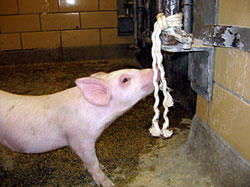Sample collection
Samples should be collected following the instructions in the Oral Fluid Sampling (PDF).
Additional helpful hints and recommendations:
- The recommended ropes are three-strand twisted, 100% cotton and 1/2” to 5/8” diameter. Cotton is an absorbent material and will hold the most oral secretions.
- Do not use nylon or poly blend ropes, as they are not absorbent and may cause cuts in the gingival tissue.
- If you have difficulty obtaining cotton ropes you can use new cotton tube socks instead.
- Do not reuse the ropes/socks. However, if you don’t get enough fluid, you can use the same rope/sock in the same pen to collect more oral fluids.
- Take samples at times when the animals are most active, and are more likely to interact with the rope. This is usually in the morning hours.
- If you have difficulty getting the pigs to chew on the rope the first time, you can entice them by shaking the rope and getting them to play with it or by flavoring it with soda, honey or sugar water.
- For nursery pigs, untwisting the rope into smaller strands makes it easier for them to chew on it. The rope will untwist on its own when finishers and breeding stock chew on it.
- Maintain the novelty of the ropes. Only put ropes in pens when collecting fluid and do not leave them in for long periods of time.
- Please pace specimens in a tube and do not send fluids in whirl pacs. Samples send in whirl pacs may be subject to additional handling charges.
- Be careful of excessive food and fecal contamination. Avoid putting the ropes too close to the feeders and waterers, and make sure they are at shoulder height (not lower).
- PCR positive results indicate the presence of the virus or bacteria being tested. However, a positive PCR result does not indicate whether the pathogen is still viable.
- Pooling of samples is not recommended. Oral fluid samples are already a pool of several pigs; pooling multiple oral fluid samples may result in the dilution of the pathogen of interest and a false negative result.
Submission preparation

It is a VDL policy to submit samples through and report results to your veterinarian. Direct involvement of your veterinarian allows for optimal management of diseases. If owner or producer would also like a copy of the report sent directly to them for their records, please include their email address in the owner information section of the submission form. Please complete the form online and print it out. This greatly decreases the chance for typos in the report, and helps keep administrative costs down.
Packing and shipping
Please complete a submission form for each farm site being tested. Please label all sample tubes with a unique identifier and include these on the sample submission form.
Samples that are not tested within 24 hours of collection should be immediately frozen for the best preservation.
Place tubes in a Ziploc bag or in a serum shipping container within a plastic Ziploc bag. Cushion in between samples with bubble wrap, newspaper or paper towels. Please do not use styrofoam peanuts.
Ship samples on ice packs in an insulated leak-proof transport container.
If you are sending glass collection tubes you must send in a padded, leak-proof container, no envelopes!
Ship to arrive within 1-5 days to the address below. Shipment should be scheduled so that it will not arrive during a weekend or holiday period.
Veterinary Diagnostic Laboratory
University of Minnesota
1333 Gortner Ave
St. Paul, MN 55108
Phone: (612) 625-8787
If you are shipping samples from outside the United States, please review these USDA Guidelines for Importation (PDF).